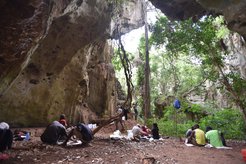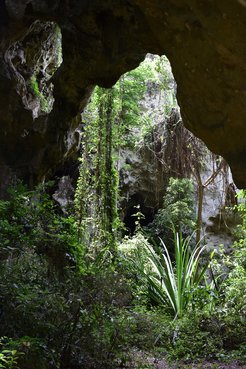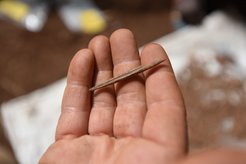Panga ya Saidi Cave, Kenya

Southern Africa has been a hotbed for important discoveries on this front, as rockshelters along the coast show intensive use some 60-70,000 years ago. Innovations like the precocious Howiesons Poort and Still Bay Industries, early marine shell beads, and abstract engravings use have solidified the significance of the southern African coast in the evolution of modern humans. Until recently, eastern Africa lacked similar long stratified sequences, which had hampered attempts to understand the regional dimension of early human developments.

Panga ya Saidi (PYS) cave is the first identified site in eastern Africa with occupation through this important time, with consistent pulses of human activity over the past 78,000 years. Panga ya Saidi is a massive karstic cave complex, first excavated in 2010 as part of the Sealinks Project, with subsequent field seasons in 2011, 2013 and 2017. The cave is perched on an escarpment that borders lowland tropical forest and savannah, approximately 10 km from the coast. Paleoecological and faunal analyses at Panga ya Saidi suggest this region has been stable throughout the history of habitation in the cave, and that the site was always within reach of the Indian Ocean. People at Panga ya Saidi would have enjoyed access to a mosaic environment with diverse terrestrial, as well as marine, resources.
Four seasons of excavations at Panga ya Saidi have already yielded important discoveries for the understanding of human evolution, but many questions remain. Excavation has focused in a partially roofed area within the cave, but the relationship between occupations in various parts of the site is unknown. Also undetermined is the full chronological sequence of Panga ya Saidi, as older undiscovered occupations may exist. Future work will explore the spatial and temporal extent of occupations, while ultimately seeking to place the finds at Panga ya Saidi within a regional network to understand the evolution of human behavior.
Related Publications

d’Errico, F., Pitarch Martí, A., Shipton, C., Le Vraux, E., Ndiema, E., Goldstein, S., Petraglia, M., Boivin, N. 2020 Trajectories of Cultural Innovation From the Middle to Later Stone Age in Eastern Africa: Personal Ornaments, Bone Artifacts, and Ocher from Panga ya Saidi, Kenya. Journal of Human Evolution. 141:102737.
Roberts, P., Prendergast, M. E., Janzen, A., Shipton, C., Blinkhorn, J., Zech, J., Crowther, A., Sawchuk, E. A., Stewart, M., Ndiema, E., Petraglia, M., Boivin, N. 2020 Late Pleistocene to Holocene Human Palaeoecology in the Tropical Environments of Coastal Eastern Africa. Palaeogeography, Palaeoclimatology, Palaeoecology. 537:109438.
Shipton, C., Roberts, P., Armitage, S., Blinkhorn, J., Crowther, A., Curtis, R., Shipton, C., Roberts, P., Archer, W., Armitage, S. J., Bita, C., Blinkhorn, J., Courtney-Mustaphi, C., Crowther, A., Curtis, R., d’Errico, F., Douka, K., Faulkner, P., Groucutt, H. S., Helm, R., Herries, A. I. R., Jembe, S., Kourampas, N., Lee-Thorp, J., Marchant, R., Mercader, J., Marti, A. P., Prendergast, M. E., Rowson, B., Tengeza, A., Tibesasa, R., White, T. S., Petraglia, M. D., Boivin, N. 2018 78,000-Year-Old Record of Middle and Later Stone Age Innovation in an East African Tropical Forest. Nature Communications. 9:1832.
Shipton, C., Helm, R., Boivin, N., Crowther, A., Austin, P. and Fuller, D.Q., 2013 Intersections, networks and the genesis of social complexity on the Nyali Coast of East Africa. African Archaeological Review, 30(4), pp.427-453.
Helm, R., Crowther, A., Shipton, C., Tengeza, A., Fuller, D. and Boivin, N., 2012 Exploring agriculture, interaction and trade on the eastern African littoral: preliminary results from Kenya. Azania: Archaeological Research in Africa, 47(1), pp.39-63.




